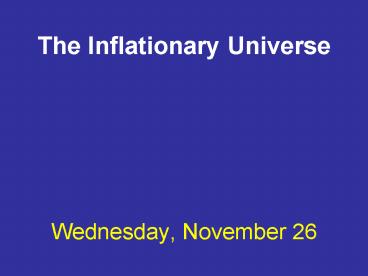The Inflationary Universe - PowerPoint PPT Presentation
Title:
The Inflationary Universe
Description:
... brief period of highly accelerated expansion, early in the history of the universe. ... The energy released by freezing water warms the leaves & fruit. ... – PowerPoint PPT presentation
Number of Views:102
Avg rating:3.0/5.0
Title: The Inflationary Universe
1
The Inflationary Universe
- Wednesday, November 26
2
The universe is very lumpy today because it was
slightly inhomogeneous when the universe became
transparent.
But why was it slightly inhomogeneous then
instead of being perfectly smooth?
3
(1) Why is the average density so close to the
critical density?
Why is the universe flat on
large scales?
(2) Why isnt the density equal to the average
density everywhere?
Why is the universe lumpy on
small scales?
4
The answers to these two questions are actually
linked!!
By explaining why the average density is close to
critical, we can also explain why there are
deviations from the average.
1st question first
5
Why should the average density of the universe
(?) be so close to the theoretical critical
density (?crit)?
Theres no law of nature that says O (
?/?crit) must be equal to one.
Why not O 0.01 or O 100?
6
Maybe its just a coincidence that O is close to
one, and space is nearly flat.
The coincidence becomes harder to explain as you
look into the past.
Why? When the universe is matter-dominated,
deviations of O from one increase with time.
7
If O is slightly less than 1, we expect
a Big Chill (O goes to zero).
If O is slightly greater than 1, we expect a Big
Crunch (O goes to infinity).
What we observe today 0.9 lt O lt 1.1
8
Today (t 13.7 billion years) 0.9
lt O lt 1.1
Transparency (t 400,000 years) 0.9997 lt O lt
1.0003
Nucleosynthesis (t 3 minutes) 1
10-14 lt O lt 1 10-14
9
At the time of Big Bang Nucleosynthesis, the
density differed from the critical density by
one part in 100 trillion, or less.
Our existence depends on this close agreement
otherwise the universe would have Crunched or
Chilled before stars could form.
10
Flatness Problem
Since the universe is fairly close to flat today,
it must have been insanely close to flat in its
early history.
What flattened the early universe?
11
Until the year 1981, cosmologists were baffled by
the flatness problem.
1981 Alan Guth proposes the idea of inflation.
12
Inflation a brief period of highly accelerated
expansion, early in the history of the universe.
Size (meters)
Time (seconds)
13
Highly relevant questions
How does inflation solve the flatness problem?
Why did the universe start inflating
exponentially ( why did it stop)?
14
According to the current model of inflation
At t 10-34 seconds, the universe started
expanding exponentially, doubling in size every
10-34 seconds.
Inflation ended at t 10-32 seconds, after
expansion by a factor 1030.
15
Today, the observable universe has a radius r
c/H0
4300 Mpc 1026 meters
At the end of inflation, it had a radius r 1
meter!
At the beginning of inflation, it had a radius r
10-30 meter!!!
16
How does inflation solve the flatness problem?
Inflation greatly increases the radius of
curvature of the universe.
17
Suppose the radius of the universe was only one
nanometer (10-9 meter) before inflation.
After inflation, the radius would be 30,000
parsecs today, 3 trillion
trillion megaparsecs.
18
v. 4.1.2 Hot Big Bang model with inflation.
19
Why did the universe start inflating
exponentially ( why did it stop)?
According to the particle physicists universe
underwent a phase transition at t 10-35
seconds.
Example of a modern phase transition water
freezes.
20
When water goes from liquid to solid, it goes
from a random state to an ordered
state.
Energy is released.
21
During a freeze in Florida, orange trees are
sprayed with water.
Why? The energy released by freezing water warms
the leaves fruit.
22
The energy released by the phase transition at t
10-35 sec acts (temporarily) like dark energy.
Expansion of the universe is accelerating now,
just as it was at t 10-35 sec. Is the
universe now undergoing a phase transition?
23
Why is the universe flat on
large scales?
Because it underwent inflation early in its
history.
Why is the universe lumpy on
small scales?
Because it underwent inflation early in its
history.
24
Inflation increases a length of 1
nanometer (the size of an atom) to 30,000 parsecs
(the size of a galaxy).
25
On subatomic scales, the universe is full of
quantum fluctuations.
A vacuum looks empty, but its full of particles
antiparticles being created destroyed.
26
This is a result of Heisenbergs Uncertainty
Principle we cant specify exactly the energy of
a subatomic patch of the universe.
Some patches are higher in energy some are lower.
27
Ordinarily, these quantum fluctuations are on
tiny scales. However, inflation increased tiny
scales (1 nanometer) to galaxy-sized scales
(30,000 parsecs)!
Cosmic Microwave Background
28
The high-density (warm) and low-density (cool)
spots on the CMB
are tiny quantum fluctuations that have been
blown up in scale.
29
Great Oaks from Tiny Acorns Grow.
A dense region will become denser more massive
with time its gravity attracts surrounding
matter.
The quantum fluctuations blown up by inflation
are the acorns.
30
Mondays Lecture
The Origin of Planets
Reading
Chapter 13































